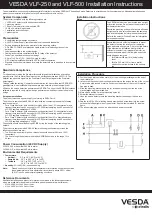
SS-300-017
1
I56-3328-000
2D51A Photoelectric Smoke Detector
for use with Innovair Flex 4-Wire Duct
Smoke Detector Housings
INSTALLATION AND MAINTENANCE INSTRUCTIONS
6581 Kitimat Road, Unit 6, Mississauga, Ontario L5N-3T5
1-800-SENSOR2, FAX: 905-812-0771
www.systemsensor.ca
BEFORE INSTALLINg
Please thoroughly read the System Sensor manual A05-1003, Applications
Guide for System Smoke Detectors, which provides detailed information on
detector spacing, placement, zoning, wiring, and special applications. Copies
of this manual are available from System Sensor.
NOTICE:
This manual should be left with the owner/user of this equipment.
IMPORTANT:
The detector must be tested and maintained regularly following
CAN/ULC S536 requirements. The detector should be cleaned at least once
a year.
gENERAL DESCRIPTION
The 2D51A photoelectronic detector uses a state-of-the-art optical sensing
chamber. This detector is designed to provide protection in duct applications
when installed with an Innovair Flex 4-wire duct smoke detector housing and
to be used with ULC listed control panels only.
Two LEDs on each detector provide local visible alarm indication. Refer to
Table 3 of the Model D4120A installation manual for LED status indications.
Remote LED annunciator capability is standard and may be implemented
through a number of optional accessories. See applicable Innovair Flex duct
smoke detector installation manual for more information.. The alarm can be
reset only by a momentary power interruption. This detector may be tested by
activating the internal reed switch with a magnet.
BASE SELECTION AND WIRINg gUIDE
Refer to the applicable Innovair Flex 4-wire duct smoke detector installation
instructions for detector head and wiring instructions.
INSTALLATION
NOTE:
All wiring must conform to applicable local codes, ordinances, and
regulations.
WARNING
Remove power from initiating-device circuits before installing detectors.
1. Install detectors:
a. Place the detector into the detector base.
b. Turn the detector clockwise until the detector drops into place.
c. Continue turning detector clockwise to lock it in place.
2. Tamper Resistance: The detector bases can be made tamper resistant.
When capability is enabled, detectors cannot be removed from the base
without the use of a tool. See the detector base installation manual of
the detector base for details in using this capability.
3. After all detectors have been installed, apply power to the control unit.
4. Test the detector using the magnet as described under TESTING.
5. Reset the detector at the system control panel or on power board.
6. Notify the proper authorities that the system is back on line.
CAUTION
Dust covers are an effective way to limit the entry of dust into smoke detector
sensing chambers. However, they may not completely prevent airborne dust
particles from entering the detector. Therefore, System Sensor recommends the
removal of detectors before beginning construction or other dust producing activ-
ity.
SPECIFICATIONS
Height:
2.0 in
Diameter:
4.1 in; 6.1 in
Weight:
3.1 oz. (88 g)
Operating Temperature Range:
–20°C to 70°C (–4°F to 158°F)
Operating Humidity Range:
0% to 95% Relative Humidity Non-condensing
Latching Alarm:
Reset by momentary power interruption
Be sure to remove the dust covers from any sensors that were left in place
during construction as part of returning the system to service.
TESTINg
Before testing, notify the proper authorities that the smoke detector system
is undergoing maintenance and will temporarily be out of service. Detectors
must be tested after installation and as part of periodic maintenance. Test the
2D51A as follows:
NOTE:
Before testing the detector, check to ensure the the power board
LEDs blink. If they do not, the detector may not have power or may not be
installed properly (check the wiring), if it is defective, or the detector sensitiv-
ity is outside the listed limits return it for repair.
ALARM TESTS
1a. Test/Reset Button - Press and hold the test button located on the power
board cover for at least 2 seconds.
OR
1b. M02-04-00 Magnet Test - Place the painted surface of the magnet onto
the MAGNET TEST location on the sensor cover of unit (Figure 1).
2. The red alarm LED on the sensor and the power board should latch
on, as should any accessories (i.e. RA400ZA, RTS451). Verify system
control panel alarm status and control panel execution of all intended
auxiliary functions (i.e fan shutdown, damper control, etc.).
3. The detector must be reset by the system control panel, front cover Test/
Reset button, or remote accessory.
4. To reset using the Test/Reset button on the power board cover simply
press and release.
RTS451/RTS451KEYA REMOTE TEST STATION
The RTS451/RTS451KEYA Remote Test Station facilitates test of the alarm
capability of the duct smoke detector as indicated in the RTS451/RTS-
451KEYA manual. The D4120A duct smoke detector can be reset by the
RTS451/RTS451KEYA. If a system control panel is used, the panel itself may
also require testing.
To install the RTS451/RTS451KEYA, connect the device as shown in the
manual provided with the accessory; wire runs must be limited to 25 ohms or
less per interconnecting wire.
SMOKE RESPONSE TESTS
To determine if smoke is capable of entering the sensing chamber, visually
identify any obstructions. Plug the exhaust and sampling tube holes to pre-
vent ducted air from carrying smoke away from the detector head, then blow
smoke such as cigarette, cotton wick, or punk directly at the head to cause an
alarm. REMEMBER TO REMOVE THE PLUGS AFTER THIS TEST, OR THE
DETECTOR WILL NOT FUNCTION PROPERLY.
SMOKE ENTRY USINg AEROSOL SMOKE
This test is intended for low-flow systems (100-500 FPM). If the air speed is
greater than 500 FPM, use a conventional manometer to measure differen-
tial pressure between the sampling tubes, as described per the installation
manual provided with the duct smoke detector.
Drill a
1
⁄
4
inch hole 3 feet upstream from the duct smoke detector. With the air
handler on, measure the air velocity with an anemometer. Air speed must be
at least 100 FPM. Spray aerosol smoke* into the duct through the
1
⁄
4
inch hole




















